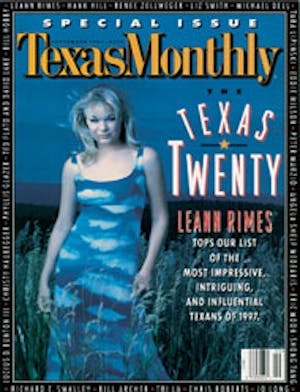This story is from Texas Monthly’s archives. We have left the text as it was originally published to maintain a clear historical record. Read more here about our archive digitization project.
It took a tragedy for everyone to notice. In March 1995 Selena was murdered, and suddenly America—which is to say the Anglo media—discovered a new, no longer silent minority. If Hispanics were willing to buy millions of records by their own Madonna, what else might they consume? The raw numbers were tantalizing: The 1990 census, which was expected to count 20 million Hispanics, uncovered 23 million. And by the year 2010, Hispanics will be America’s largest minority group.
Those numbers sound just fine to Christy Haubegger. Last summer the 29-year-old Houston native founded Latina, a glossy lifestyle magazine targeted to Hispanic women like herself. Published in New York, Latina is filled with profiles of prominent Hispanics—from teenage singer Jennifer Pea to Chicago city treasurer Miriam Santos—and stories about health, politics, money, and self-esteem building. Like its Anglo counterparts, it also has ample fashion and beauty advice, only the skin, hair, and eyes in question are brown. Because the Hispanic market is booming, Haubegger (who serves as the magazine’s publisher) has her share of competition, from Spanish-language editions of People and Newsweek to more-modest efforts like Austin-based Hispanic and Moderna. But after only a year, Latina‘s circulation is approaching 200,000 and growing, Haubegger says, and its advertisers include many of publishing’s top draws: the Gap, Honda, and Revlon.
As the adopted daughter of Anglo parents, Haubegger grew up without many ethnic role models. Other Hispanic kids were frustrated by a lack of popular images in the media, she says, but at least when they went home, they found people who looked like they did. David and Ann Haubegger worked hard to instill in their daughter a strong sense of her heritage, and they gave her Spanish lessons from an early age, but the absence of Hispanic media icons resonated with her just like it would any other girl. Haubegger says that as a teenager, she couldn’t help but notice that you never saw anyone with brown eyes in Seventeen magazine.
That void became an entrepreneurial inspiration. After earning a degree in Spanish and philosophy at the University of Texas and graduating from Stanford Law School, she resolved to try her hand at publishing. “I didn’t know that I couldn’t do it,” she says—but a group of venture capitalists including Edward Lewis, the founder and owner of the black women’s magazine Essence, thought she could, and invested several million dollars on the strength of her 75-page business plan.
Ever since, Haubegger has taken pains to connect with her readers, who are mostly second-generation U.S. citizens battling stereotypes and walking a fine line between the old world and assimilation. Language is one tool at her disposal. “People enjoy the fact that it sounds like they do,” she says. “Sometimes we say the magazine is trilingual: Spanish, English, and Spanglish.” Advertising is another: The ads in Latina feature Latina models as well as familiar Anglos like Cindy Crawford and Christy Turlington (who, ironically, has pitched colored contact lenses). Airbrushed shots of models aren’t any closer to the average Latina than those blond Seventeen cover girls, but “people want to see aspirational images of beauty,” Haubegger says. “It’s very important for us to see Jennifer Lopez on the newsstand next to Claudia Schiffer and say she looks just as good—if not better.”
Assimilation, of course, cuts both ways. Recently Haubegger has been attacked by Alfredo Estrada, the owner of Moderna and Hispanic, who complains that the majority of Latina‘s investor-owners aren’t Hispanic; by Estrada’s logic, the magazine takes money out of the pockets of Hispanic businesses. Haubegger counters that she is a vocal partner in the venture and that her staff is almost exclusively Hispanic and female; what’s more, she points out, Estrada’s doctrinaire attitude would require Hispanic consumers to boycott the Selena movie (brought to you by Time Warner, just like People en Español) or Jon Secada CDs (released by British-owned EMI).
And, anyway, all Haubegger really cares about is her readers. “Women pick up this magazine,” she says, “and it’s like they’re looking in the mirror for the first time. And smiling.”







